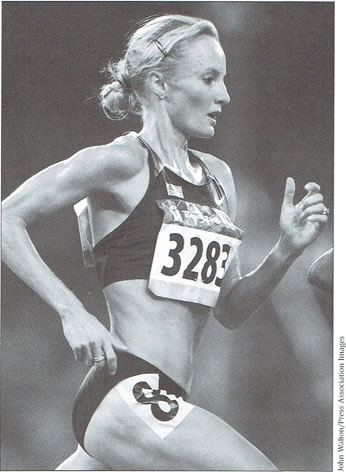|
Breathing Rhythms By: Jack Daniels, PhD Originally Published in: Daniels Running Formula - Human Kinetics
When not running very hard, you may breathe in for three steps and breathe out for three steps, and you may stay with this rate even when you feel the need to breathe harder, by just increasing the size of each breath. By running a little harder, you feel the need to ventilate even more, so you switch to a faster breathing rhythm; for runners this is usually by taking two steps while breathing in and two steps while breathing out (referred to as a 2-2 breathing rhythm). Most accomplished runners breathe with a 2-2 rhythm, especially when running fairly hard, because it is comfortable and allows a sizable amount of air to be breathed in and out of the lungs. I strongly recommend using a 2-2 rhythm during practice and in competition, at least during the first two-thirds of middle-distance races, as I explain later in the chapter. You may be able to breathe at a slower rate when running slowly, but it is usually better to use that good 2-2 rhythm even in easy runs, and in threshold, interval, and repetition workouts, so it becomes natural. Now, let's go to a 3-3 rhythm, which may reduce the amount of each breath to 3.5 liters per breath, which means you are now moving 3.5 liters in and out, 30 times per minute, and 30 x 3.5 = 105 liters per minute, 16 percent more air per minute. Now, let's try a 2-2 breathing rhythm, which will give you 45 breaths per minute and about 3 liters per breath. In this case you move 135 liters of air per minute (3 x 45 = 135), which is doing a better job of ventilating the lungs, reducing CO2 buildup, and increasing the 02 content of the air in your lungs. We can go one step further and try a 1-1 breathing rhythm (something you often heal- novice runners doing at the end of a hard race). With this rate of breathing, the size of each breath will be greatly reduced, and the total amount of air moved in and out may not even be as much as can be accomplished with a slower yet deeper rate. In addition, realize that a portion of each breath you move through your mouth and nose is dead-space air, the air that does not reach the lungs for gas exchange. The faster the breathing rate, the greater portion of each breath, and of each minute, is not involved in 0, and CO, exchange. Obviously, faster breathing rates are a little more costly in terms of energy expenditure of the breathing muscles, but at some point, the ventilation factor, along with the cost factor, usually ends up favoring a breathing rhythm of somewhere around a 2-2 (or 2-1) rhythm. Taking three steps per breathing cycle (using a 2-1 or 1-2 rhythm) gives you 60 breaths per minute (1 each second). This probably allows for the greatest amount of air to be moved per minute while running, but it is usually not necessary until you are working very hard, such as in the last part of a 5K or 10K race. Of all the elite runners I have tested in the lab, about 86 percent of them automatically choose a 2-2 rhythm until working at maximum, at which time they go to 2-1 or 1-2. Whether the elite runners have learned over the years that this is the most efficient approach, or whether someone has suggested this to them, it makes sense to adjust to this rhythm early in a career without having to wait for it to become the natural thing to do. One way I demonstrate the effects of the different breathing rhythms to my runners is to ask them to run five laps on the track (just at moderate intensity, not racing). For the first lap they are to breathe with a 4-4 rhythm, then 3-3 for lap two, 2-2 for lap three, 1-1 for lap four, and back to 4-4 for lap five. Then I ask them which was most stressful and which was most comfortable. Something that works quite well with younger runners is to have them breathe with a 2-2 rhythm for the first two-thirds of a race (e.g., first 2 miles of a 5K cross country race), then go to 2-1 or 1-2 for the final third of the race. If they can't manage 2-2 for the first two-thirds of the race, it tells them they have gone out too fast, and next time they are to set an easier early pace. How much air any particular runner moves in and out of the lungs per minute varies a great deal. Two Olympians I tested were similar in size and in performance, but during a maximum-effort test, one breathed 160 liters per minute and the other 224 liters per minute. One was breathing just over 2.6 liters per breath and the other just over 3.6 liters per breath. People definitely vary in minute ventilation and in the size of each breath, but it is not necessarily an advantage or disadvantage to be a heavy or light breather, so do not worry about how you operate. One situation where a faster breathing rate is a little easier is when running at altitude. The air at altitude is less dense and offers less resistance to flowing in and out of the breathing airways. I have known at least two great runners who used a 1-1 breathing rhythm at altitude when working really hard. A runner can also use the knowledge of breathing rhythm to determine how hard she is working. If you can breathe comfortably with a 3-3 rhythm during a long steady run, this means you are not working too hard, but if you feel you must breathe 2-2 to get enough air, then you are not working that easily. I am not suggesting that you use a 3-3 breathing rhythm during all easy long runs (2-2 is still probably the way to go), but that giving 3-3 a try for a few minutes would tell you how hard you are working. This is similar to knowing you are going too hard during threshold running (i.e., if you can't use a 2-2 rhythm and have to go to 2-1 or 1-2). I'm not suggesting you need to constantly monitor your breathing, but it is good to know how you can use this information during training and racing to judge the effort you are putting forth.
|








